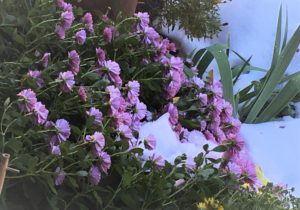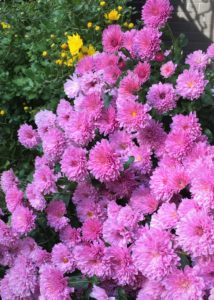Wisteria is another kind of purple waves in May that brings me nostalgia. Their images are commonly found in Chinese and Japanese paintings—feminine and refined. In my old neighborhood, there was a house draped with wisteria vines. It later became a tea shop frequented by college students, artists, writers and activists.[1]

Here, trained wisterias grow in gardens and climb around houses. In the wilderness, they lean on rocks or hang from trees in the forests. A friend lives near an unattended woodland by a creek where wisterias cohabit with some great trees. Every spring, their blossoms cascade from treetops to the ground, connecting the sky and the earth. It was their perfume that alerted me of their existence. Since then, I have watched them blooming in the spring and producing long seed pods over the summer. Later in the season, the pods would mature, dry up and pop open, shooting out the seeds.
These seeds have the color of medium-roasted coffee beans. They are smooth and shiny like shirt buttons. With the help of wind, the seeds would jump and fly, crossing water and roads, allowing fates to determine their future. I loved collecting and putting them in small dishes, watching them with the eyes of a child looking at candies.
A few years ago, when building a garden, I put a few wisteria seeds on top of the rock on the northern end of our property. I kept and started training one young plant. This spring it started to behave like a cultivated plant: no runner roots nor out-stretching shoots. The stem became stronger and more upright. Clouds of yellow green new leaves could be seen from the sidewalk below.


It is said that wisteria growing from seeds will take up to fifteen years to bloom. I also notice that, sometimes, in shaded woods, wisteria runners cover the ground but do not bloom. In a New York Times article, the owner of a wisteria-draped brownstone said that maintaining the plant was like owning a pet.[2] I am keeping an eye on my pet and looking patiently into the future.
[1]Wistaria_Tea_House_Taipei
[2] A-Roller-Coaster-Ride-of-Style: New York Times


